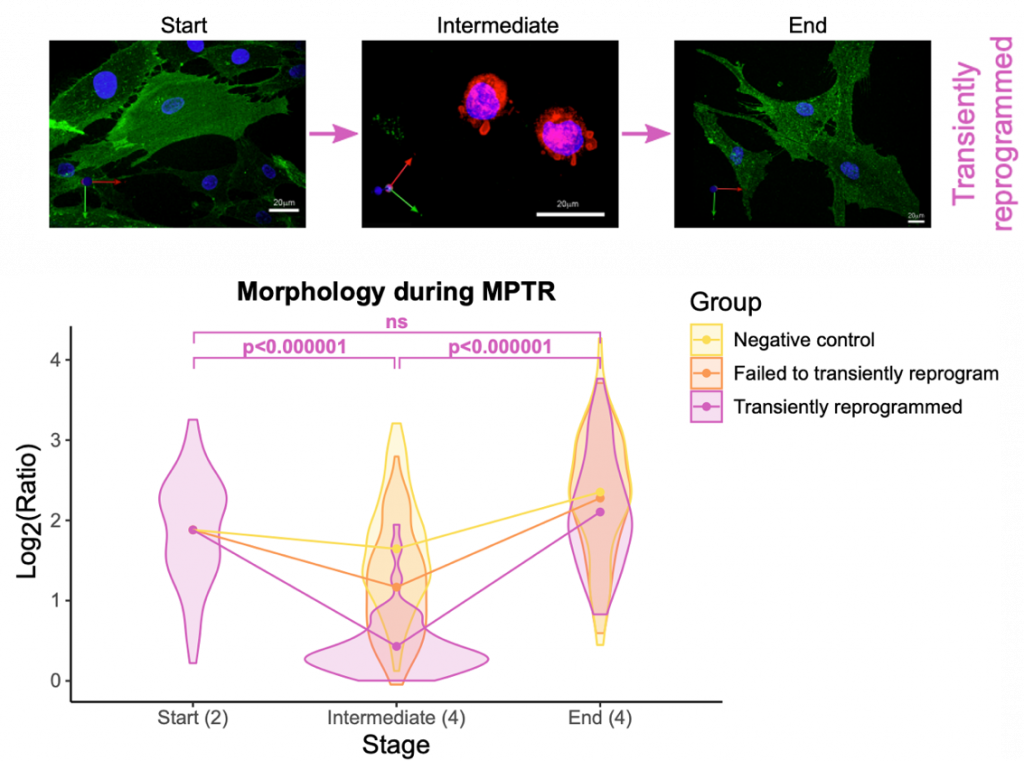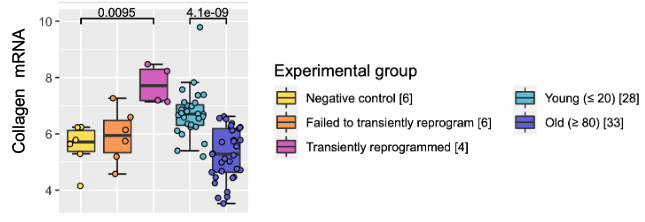Key Points:
- A new method of genetic reprogramming rejuvenates skin cells by 30 years, importantly, without losing their identity.
- Rejuvenated skin cells produce more collagen and heal faster, signs of younger skin.
- This reprogramming method could potentially be used to treat multiple age-related diseases, including Alzheimer’s disease and cataracts.
If you could rewind the age of your cells back to zero, would you? Given that all your cells used to be embryonic cells, you might think twice. Not many of us want to reverse our age back to the time of birth like Benjamin Button. But what if we could reverse our age by a few years or decades?
For a while now, scientists have been able to reprogram adult cells to become like embryonic stem cells – the cells that make up an embryo and eventually develop into a full-grown adult. These experimentally programmed embryonic stem cells (induced pluripotent stem cells) have a biological age of approximately zero, giving them potential for anti-aging therapy. However, the problem is that these cells lose their original identity since they become embryo-like cells. Gill and colleagues from the Babraham Institute in the United Kingdom may have found a way around this problem, as they report in eLife that they can reprogram and rejuvenate skin cells while maintaining their skin cell identity.
The lead author of the study, Dr. Diljeet Gill, who conducted the work as a PhD student says, “Our understanding of aging on a molecular level has progressed over the last decade, giving rise to techniques that allow researchers to measure age-related biological changes in human cells. We were able to apply this to our experiment to determine the extent of reprogramming our new method achieved.”
Age-Reversal to Look and Heal Younger
Gill and colleagues employed partial reprogramming on human skin cells (fibroblasts) from three middle-aged donors, chronologically aged 38, 53, and 53 and biologically (epigenetically) aged 45, 49, and 55. The skin cells underwent dramatic changes in shape during reprogramming. Particularly, they became rounder, consistent with the shape of an embryonic stem cell. Importantly, they returned to their original elongated skin cell shape and identity by the end of reprogramming. Furthermore, the biological age of the partially reprogrammed skin cells was rejuvenated to be 30 years younger. Overall, these results demonstrate that partial reprogramming can reverse biological aging while maintaining cell identity.

Gill and colleagues further profiled the effects of partial reprogramming by measuring the functional outcomes of changes in specific genes. One of these genes was for collagen, a structural protein that keeps skin hydrated and firm. [Fibroblast] skin cells are responsible for collagen production, which decreases as we age. The English researchers not only showed that partial reprogramming activated the collagen gene but also increased the level of collagen protein and wound healing speed. These results indicate that MPTR, in principle, restores youthful functionality in human skin cells.
Gill concluded: “Our results represent a big step forward in our understanding of cell reprogramming. We have proved that cells can be rejuvenated without losing their function and that rejuvenation looks to restore some function to old cells. The fact that we also saw a reverse of aging indicators in genes associated with diseases is particularly promising for the future of this work.”

Overcoming Cell Identity Crisis
Take a muscle cell; its function is to contract. If completely reprogrammed to an embryonic stem cell, it loses its identity as a muscle cell and, therefore, its function. Thus, in the context of anti-aging therapy, it becomes useless. Even if it has a biological age of 0, what good is a muscle cell that can’t contract? This goes for all adult cells, which each serve their own particular function.
Scientists have already been able to partially reprogram cells while keeping their original identity but without ideal results. There are three phases to reprogramming, achieved by activating specific genes known as Yamanaka factors, typically active in embryonic cells. For complete reprogramming, the Yamanaka factors are activated throughout all three phases. For partial reprogramming, the Yamanaka factors are activated only throughout the first phase. This type of transient reprogramming can extend the lifespan and improve cell function in mice but only reverses biological age by around three years. For this reason, Gill and colleagues studied a new partial reprogramming strategy called MPTR (maturation phase transient reprogramming), where Yamanaka factors are activated up to the second phase of reprogramming.
Cell Reprogramming Therapy
Gill and colleagues demonstrate that skin cells can be reprogrammed to a younger age with MPTR, but the implications of these findings are not only skin deep. Upon further interrogation of gene activation during reprogramming, the researchers observed changes in genes with non-skin cell functions. There were age-associated changes in genes linked to Alzheimer’s disease and cataracts, suggesting that MPTR could potentially treat age-related diseases like these.
How could MPTR be utilized to treat age-related diseases and other ailments? A biopsy could be taken from an individual’s body, rejuvenated in a dish via MPTR, then reintroduced into the body to heal damaged tissue. For example, rejuvenated skin cells could be reintroduced to an individual’s wound to improve wound healing. However, for this to work the method will require modification, as Yamanaka factors have the potential to cause tumors. Other things to be worked out include what age to start MPTR, and if multiple MPTR cycles could further increase youthfulness. If this can all be worked out, cell reprogramming therapy has a good outlook for the future.
The senior author, Dr. Wolf Reik said, “This work has very exciting implications. Eventually, we may be able to identify genes that rejuvenate without reprogramming, and specifically target those to reduce the effects of aging. This approach holds promise for valuable discoveries that could open up an amazing therapeutic horizon.”